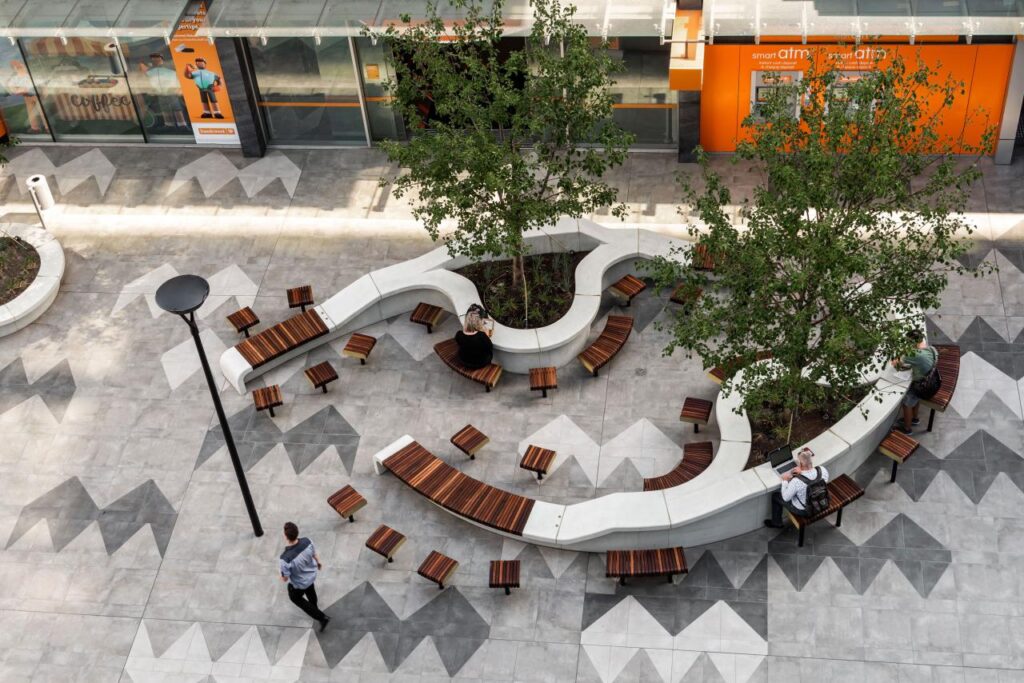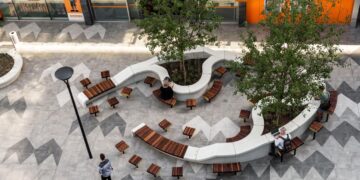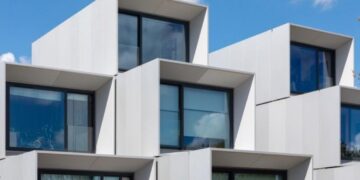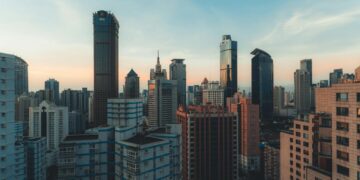Urban centers around the world are at a crossroads. As cities continue to grow in population and density, architects and urban planners face the monumental challenge of creating spaces that are not only functional and efficient but also sustainable, resilient, and human-centered. The architecture of the past, with its focus on isolated, monumental structures, is giving way to a new, interconnected paradigm. The year 2025 marks a pivotal point where a number of groundbreaking architectural innovations are moving from theory to reality. This article will explore the most significant trends that are reshaping our urban landscapes, from vertical ecosystems and adaptive reuse to smart, data-driven design, all aimed at building cities that are better equipped to handle the demands of the future.
The Rise of Vertical Ecosystems

With limited horizontal space, cities must expand vertically. However, this is no longer just about building taller towers. The new trend is to create vertical ecosystems that integrate nature and agriculture into high-rise structures, transforming them into self-sustaining habitats.
A. Vertical Farms: To address food security in densely populated areas, architects are designing buildings with integrated vertical farms. These multi-story farms use hydroponic or aeroponic systems to grow crops year-round, regardless of external weather conditions. This significantly reduces transportation costs and carbon emissions associated with food production and delivery.
B. Living Walls and Green Roofs: These features are becoming standard, not just for aesthetics but for their functional benefits. Living walls, covered with a variety of plants, help to purify the air, reduce a building’s energy consumption by providing insulation, and create a calming visual environment. Green roofs similarly absorb stormwater, mitigate the urban heat island effect, and provide new public spaces for recreation and relaxation.
C. Biophilic Skyscrapers: Architects are creating skyscrapers that incorporate nature at every level. This includes atriums with indoor forests, sky gardens that provide a green escape from the concrete jungle, and balconies that are designed to be personal gardens. This brings the proven benefits of biophilic design to a vertical context, enhancing the well-being of occupants.
Adaptive Reuse and Urban Regeneration
Instead of demolishing old buildings and starting from scratch, a major trend in modern urban architecture is adaptive reuse, which involves repurposing existing structures for new functions. This practice is both economically savvy and environmentally responsible.
A. Breathing New Life into Old Structures: Old factories, warehouses, and even power plants are being converted into vibrant mixed-use developments, including residential lofts, offices, and cultural centers. This preserves a city’s historical character and reduces the massive environmental impact of new construction.
B. Flexibility in Design: Adaptive reuse projects often require a flexible approach to design. Architects must work with the existing structural limitations, which often leads to creative and unique spaces. This flexibility is key to creating dynamic urban environments that are constantly evolving to meet the needs of the community.
C. Economic and Social Benefits: By revitalizing underutilized spaces, adaptive reuse projects can stimulate economic growth in neglected neighborhoods. They also foster a sense of community by preserving a building’s history and providing new, innovative spaces for people to live, work, and gather.
Smart Urban Infrastructure and Data-Driven Design
The cities of 2025 are becoming intelligent, with an underlying network of sensors and data analytics that informs and optimizes urban life. This smart urban infrastructure is transforming how we design and manage cities.
A. Real-Time Data Analytics: Architects are using real-time data on traffic flow, public transit usage, and pedestrian movement to design more efficient public spaces, transportation networks, and building layouts. For example, a building’s entrance could be designed to accommodate peak traffic times based on data from public transit schedules.
B. Responsive Buildings: The buildings themselves are becoming responsive to their environment and occupants. Smart systems can adjust lighting, temperature, and ventilation based on occupancy and external weather conditions, leading to massive energy savings. These systems can also predict maintenance needs, ensuring that a building remains efficient and safe.
C. The Internet of Things (IoT) in Urban Planning: The IoT provides a nervous system for the modern city. Connected sensors in streetlights, trash cans, and public transport systems generate data that helps city officials manage resources more effectively, improve public services, and respond to emergencies in real-time.
Modular and Prefabricated Construction
To meet the urgent demand for housing and infrastructure, cities are increasingly turning to modular and prefabricated construction. This method involves manufacturing building components off-site in a factory and then assembling them on-site.
A. Speed and Efficiency: Modular construction is significantly faster than traditional methods, as different parts of the building can be manufactured simultaneously with site preparation. This reduces construction timelines by as much as 50%, which is crucial for high-density urban areas.
B. Reduced Environmental Impact: Factory production allows for precise measurements and a higher degree of quality control, which leads to less material waste. The off-site production also reduces noise pollution, traffic congestion, and dust on the construction site, making it a more environmentally friendly option for cities.
C. Cost-Effectiveness and Quality: While the initial setup for a modular factory can be expensive, the long-term cost-effectiveness is undeniable due to faster timelines and less waste. The controlled environment also leads to a higher quality of construction, with fewer defects and a more durable final product.
Resilient and Climate-Adapted Architecture
As cities become more vulnerable to the effects of climate change, from extreme weather events to rising sea levels, architects are focusing on resilient and climate-adapted design. This involves creating structures that can withstand environmental shocks and stresses.
A. Designing for Extreme Weather: Buildings are being designed with features to mitigate the effects of hurricanes, floods, and extreme heat. This includes elevated foundations, flood-resistant materials, and advanced insulation to keep interiors cool without relying on energy-intensive air conditioning.
B. Sustainable Materials and Passive Design: The use of sustainable materials is a key part of resilient architecture. For example, using recycled or locally sourced materials reduces the carbon footprint of a building. Passive design strategies, such as maximizing natural light and ventilation, also make a building more resilient by reducing its dependence on external energy sources.
C. Green Infrastructure: Urban planners are incorporating “green infrastructure” into their designs, such as rain gardens, permeable pavements, and urban forests. These features help to manage stormwater runoff, reduce urban flooding, and provide a natural defense against environmental shocks.
The Integration of Community-Focused Design
Modern urban architecture is moving away from purely commercial or residential spaces and towards community-focused design. This involves creating mixed-use developments that serve as hubs for social interaction and civic life.
A. Mixed-Use Developments: Buildings are being designed to integrate residential, commercial, and public spaces into a single structure or complex. This creates a vibrant, 24/7 environment where people can live, work, shop, and socialize without the need for extensive travel.
B. Public Spaces and Placemaking: Architects are giving more attention to the public spaces within and around buildings. This includes creating plazas, parks, and rooftop gardens that serve as gathering spots for the community. Placemaking is the process of creating high-quality public spaces that attract people and foster a sense of belonging.
C. Promoting Walkability and Connectivity: Modern urban architecture is focused on creating pedestrian-friendly environments. This includes designing buildings with ground-floor retail, clear sightlines, and easy access to public transportation, which encourages walking and reduces reliance on cars.
Conclusion
The urban architectural landscape of 2025 is defined by a fundamental shift from a rigid, monolithic approach to a dynamic, interconnected, and human-centric one. The innovations we have explored, from vertical ecosystems that bring nature into the city to resilient designs that combat climate change, are not isolated ideas. They are interconnected threads that are weaving together to create a new vision for urban living. The modern city is becoming a living organism, intelligent and responsive, with an architectural framework that prioritizes efficiency, sustainability, and human well-being.
These trends represent a powerful fusion of technology, ecology, and social responsibility. By embracing adaptive reuse, we honor our past while building for the future. By implementing smart infrastructure, we make our cities more efficient and responsive. By focusing on community-focused design, we build spaces that foster connection and belonging. The long-term impact of these architectural innovations will be immense. They will not only make our cities more livable but also more equitable and resilient in the face of future challenges. The buildings we design today will be the foundation for a more sustainable and harmonious urban future, a testament to our ability to innovate and create spaces that truly serve the people who inhabit them.












